-
ARTÍCULO ORIGINAL08/12/2024
Initial nipple damages in breastfeeding women: analysis of photographic images and clinical associations
Revista Brasileira de Enfermagem. 2024;77(1):e20220773
Resumen
ARTÍCULO ORIGINALInitial nipple damages in breastfeeding women: analysis of photographic images and clinical associations
Revista Brasileira de Enfermagem. 2024;77(1):e20220773
DOI 10.1590/0034-7167-2022-0773
Visualizações0Ver maisABSTRACT
Objective:
to analyze the initial nipple damage degree by breastfeeding practice and to associate findings with clinical manifestations of breastfeeding women.
Methods:
a retrospective, cross-sectional study with primary data and photographic images database from two randomized clinical trials. Photographic images were analyzed by two independent evaluators using the Nipple Trauma Score. For analysis, the chi-square, Mann-Whitney tests and Kappa coefficient were applied.
Results:
115 breastfeeding women and their respective 186 photographic images were analyzed. The degree of agreement of evaluators using the Nipple Trauma Score was 93.6%. The nipple pain score during breastfeeding was moderate and compromised more than 25% of the nipple surface area.
Conclusions:
assistance to breastfeeding women should prioritize nipple pain intensity instead of the nipple damage size.
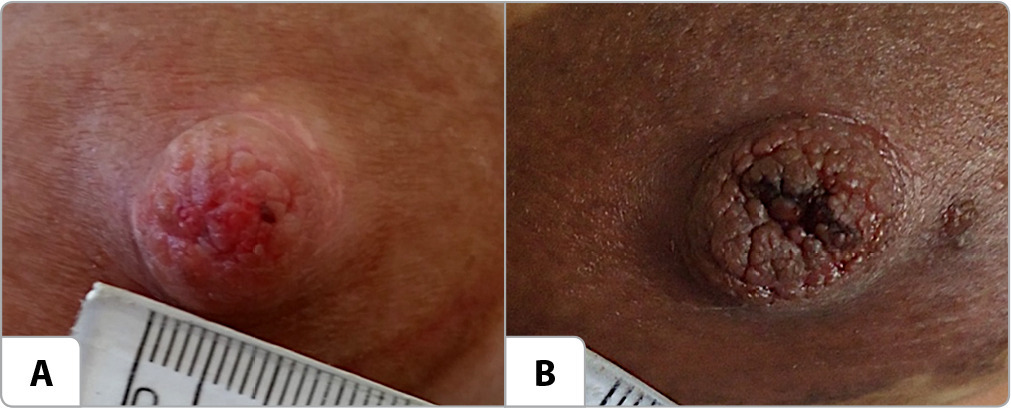
-
ARTÍCULO ORIGINAL08/12/2024
Safe practices for bed bathing in the intensive care unit: validation of a checklist
Revista Brasileira de Enfermagem. 2024;77(1):e20230135
Resumen
ARTÍCULO ORIGINALSafe practices for bed bathing in the intensive care unit: validation of a checklist
Revista Brasileira de Enfermagem. 2024;77(1):e20230135
DOI 10.1590/0034-7167-2023-0135
Visualizações0Ver maisABSTRACT
Objective:
To validate a checklist for safe bathing in critically ill patients.
Methods:
This is a methodological and quantitative study. Researchers developed a checklist for safe bathing in critically ill patients consisting of 41 items, which were submitted to the apparent and content validation process, evaluated by eleven judges, and interobserver reliability. For reliability analysis, the instrument was applied in 54 bed bath procedures in the ICU; Kappa and CHF tests were used.
Results:
In the apparent and content validation, adjustments were made according to the judges’ suggestions. Kappa values ranged from moderate to almost perfect (0.462 to 0.962), and, in some items, there was 100% agreement; the reliability of the instrument was excellent (ICC = 0.962).
Conclusion:
The instrument proved to be dependable and easy to apply. Its use will contribute to safe bed bathing and subsidize interventions aimed at increasing the quality of care.
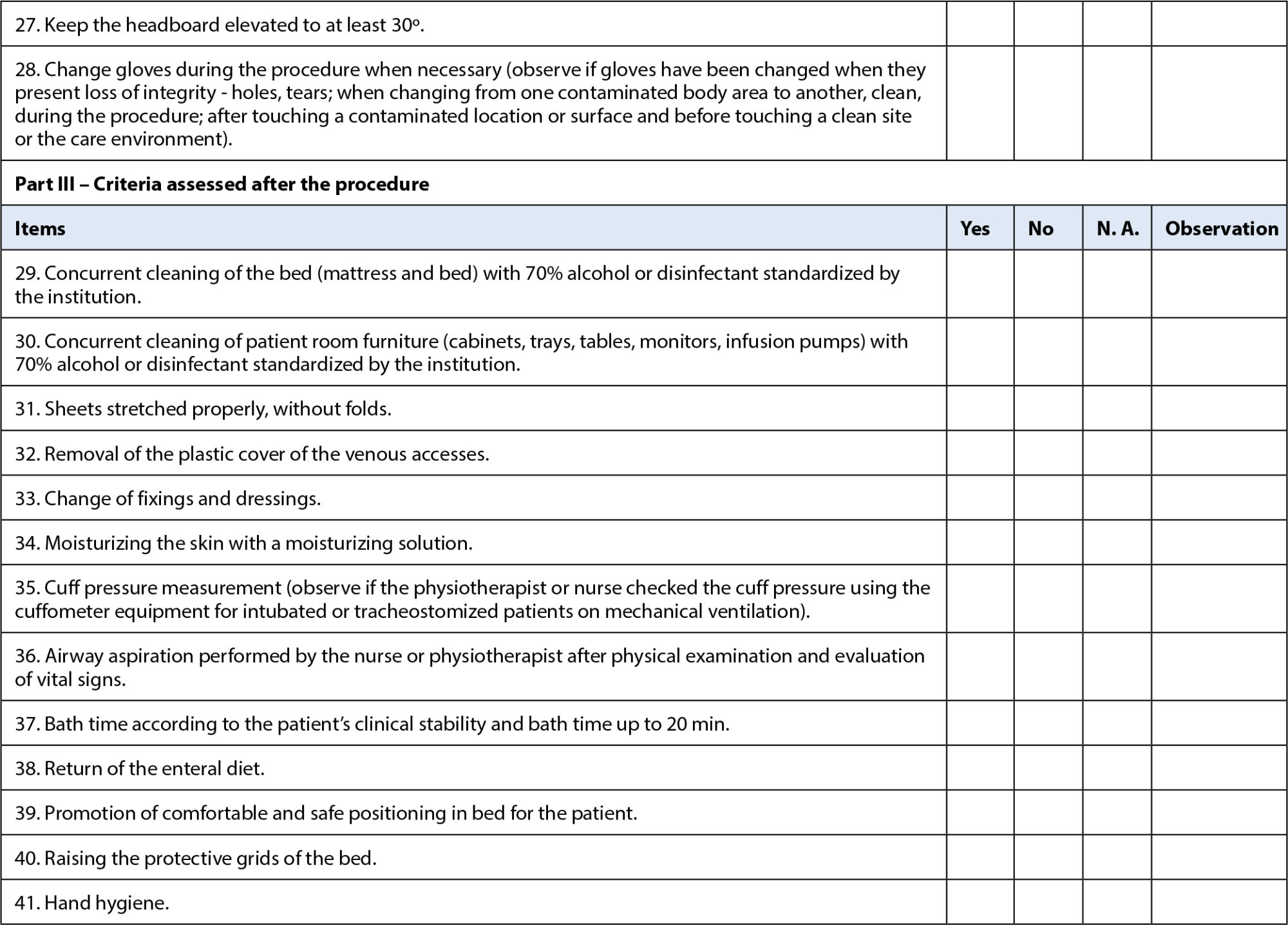
-
ARTÍCULO DE REVISIÓN29/11/2024
Assessment of knowledge in oncology about care for transgender people: a scoping review
Revista Brasileira de Enfermagem. 2024;77:e20230532
Resumen
ARTÍCULO DE REVISIÓNAssessment of knowledge in oncology about care for transgender people: a scoping review
Revista Brasileira de Enfermagem. 2024;77:e20230532
DOI 10.1590/0034-7167-2023-0532
Visualizações0Ver maisABSTRACT
Objective:
to identify evidence available in the literature on instruments and methodologies used to assess healthcare professionals’ knowledge about cancer care for the transgender population.
Methods:
a scoping review was conducted in seven databases, including studies that answered the question: what is the healthcare professionals’ level of knowledge about cancer care for the transgender population?
Results:
forty-one articles were selected that dealt specifically with healthcare professionals’knowledge in relation to care for the LGBTQIAPN+ population, especially the transgender population. Eighteen studies assessed patients’ perceptions of professionals’knowledge, whereas other studies used their own assessment tools, considering the global context of LGBTQIAPN+ health.
Conclusions:
there is no tested and validated instrument that assesses the knowledge about the transgender population’s oncological health, highlighting the need to construct and validate an instrument focused on this population’s needs.
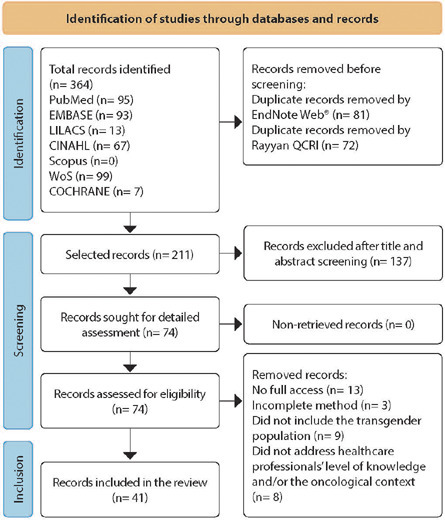
-
ARTÍCULO ORIGINAL29/11/2024
Sleep quality of vulnerable elderly people: associated factors
Revista Brasileira de Enfermagem. 2024;77:e20230283
Resumen
ARTÍCULO ORIGINALSleep quality of vulnerable elderly people: associated factors
Revista Brasileira de Enfermagem. 2024;77:e20230283
DOI 10.1590/0034-7167-2023-0283
Visualizações0Ver maisABSTRACT
Objective:
To identify factors associated with poor sleep quality in elderly dependent individuals in social vulnerability.
Method:
Cross-sectional study with 59 elderly dependent individuals assisted by Family Health Units in São Carlos/SP. The following tools were used: Katz Index, Lawton and Brody Scale, Pittsburgh Sleep Quality Index, Addenbrooke’s Cognitive Examination Revised, Fried’s Frailty Phenotype, Geriatric Depression Scale (15 items), Perceived Stress Scale, Family APGAR, Social Support Scale from the Medical Outcomes Study, and World Health Organization Quality of Life, abbreviated and “old” versions.
Results:
The majority of participants were women (52.5%), aged 60-74 years (71.1%), and had poor sleep quality (76.2%). Stress (OR=1.12; 95%CI=1.02-1.22) and polypharmacy (OR=7.39; 95%CI=1.22-44.73) increased the chances of poor sleep quality, while physical activity decreased these chances (OR=0.15; 95%CI=0.02-0.79).
Conclusion:
Stress and polypharmacy are associated with poor sleep quality in elderly dependent individuals.
-
ARTÍCULO DE REVISIÓN22/11/2024
Transition to family parenting in the face of the first child: a scoping review
Revista Brasileira de Enfermagem. 2024;77(5):e20230487
Resumen
ARTÍCULO DE REVISIÓNTransition to family parenting in the face of the first child: a scoping review
Revista Brasileira de Enfermagem. 2024;77(5):e20230487
DOI 10.1590/0034-7167-2023-0487
Visualizações1Ver maisABSTRACT
Objectives:
to identify and summarize the elements that characterize the family transition process in relation to the first child.
Methods:
a scoping review was carried out based on JBI methodology, in six databases, following the Preferred Reporting Items for Systematic reviews and Meta-Analyses extension for Scoping Reviews checklist.
Results:
ten articles were included with factors characterizing the transition, such as hindering/facilitating conditions that influence the process, important support structures in adaptation and strategies/responses used in the transition process.
Final Considerations:
elements characterizing the transition process in relation to the first child were identified. However, no theoretical explanation for this was identified. Further research should be carried out to obtain a deeper understanding of this process.
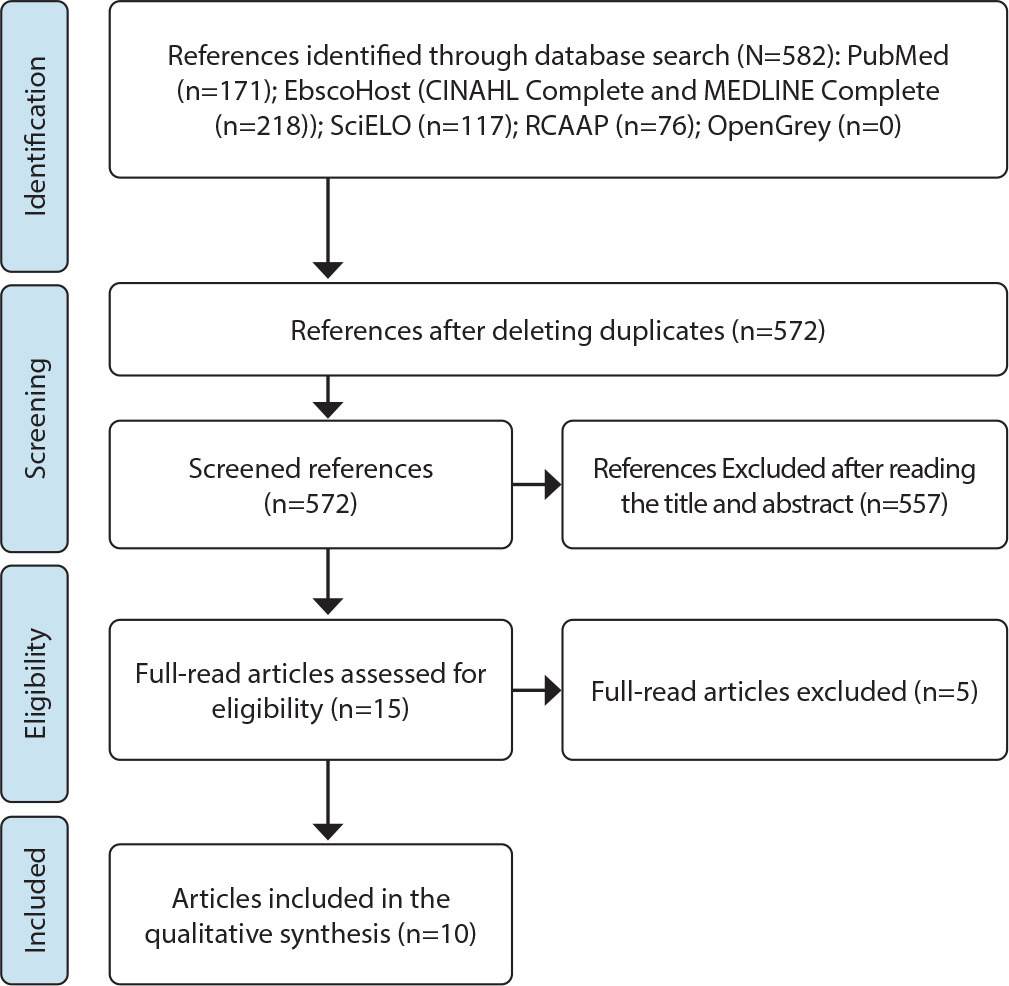
-
22/11/2024
Social Technology in the Prevention of Adolescent Violence: documentary production
Revista Brasileira de Enfermagem. 2024;77(5):e20230298
Resumen
Social Technology in the Prevention of Adolescent Violence: documentary production
Revista Brasileira de Enfermagem. 2024;77(5):e20230298
DOI 10.1590/0034-7167-2023-0298
Visualizações0Ver maisABSTRACT
Objective:
To report the development of a technological innovation in the form of a documentary, aimed at disseminating actions for preventing violence against adolescents within the context of Primary Health Care.
Methods:
The documentary was developed through action research and interventions with adolescents in the territory of a Health Unit, conducted between 2020 and 2022, using Social Technology as both an action strategy and a conceptual reference.
Results:
The Social Technology proposal, created through workshops and seminars, resulted in a documentary focusing on violence prevention, involving 48 adolescents. The documentary’s script, collectively developed, portrays a soccer match between teams symbolizing peace and violence, with peace ultimately prevailing. The documentary is six minutes long.
Final Considerations:
The documentary has proven to be an effective Social Technology tool among adolescents, as it fosters critical thinking, is accessible, has potential for digital dissemination, and appeals to the target audience.
-
ARTÍCULO ORIGINAL22/11/2024
Prevalence of prescription and effectiveness of analgesia for treating vaginal delivery pain
Revista Brasileira de Enfermagem. 2024;77(5):e20230327
Resumen
ARTÍCULO ORIGINALPrevalence of prescription and effectiveness of analgesia for treating vaginal delivery pain
Revista Brasileira de Enfermagem. 2024;77(5):e20230327
DOI 10.1590/0034-7167-2023-0327
Visualizações0Ver maisABSTRACT
Objectives:
to assess pain management during labor.
Methods:
a cross-sectional study was carried out by reviewing medical records and conducting postpartum interviews. Prevalence and effectiveness of analgesia were assessed.
Results:
the prevalence of non-pharmacological analgesia was 61.86% of 215 women in labor in Obstetric Center and 82.51% of 62 in midwife-led unit. Prevalence of severe pain, on the Visual Analogue Scale, before and after non-pharmacological analgesia, was from 92.16% to 64.04% (p=0.00) in Obstetric Center and from 85.96% to 52.63% (p=0.01) in midwife-led unit. Prevalence of pharmacological analgesia in Obstetric Centers was 15.81%, with no variation in severe pain (p=0.57). Patients’ request for analgesia was associated with education (p=0.00) and pain intensity (p=0.02).
Conclusions:
non-pharmacological analgesia improved pain intensity. Prevalence of pharmacological analgesic prescription was lower than that identified in developed countries. Pain management needs to consider the preferences and needs of women in labor.
-
ARTÍCULO ORIGINAL19/08/2019
Interrupções e carga de trabalho de enfermagem durante a administração de medicamentos
Revista Brasileira de Enfermagem. 2019;72(4):1001-1006
Resumen
ARTÍCULO ORIGINALInterrupções e carga de trabalho de enfermagem durante a administração de medicamentos
Revista Brasileira de Enfermagem. 2019;72(4):1001-1006
DOI 10.1590/0034-7167-2018-0680
Visualizações0RESUMO
Objetivo:
Investigar fontes e causas das interrupções durante o processo de administração de medicamentos realizado pela equipe de enfermagem e mensurar sua frequência, duração e impacto sobre a carga de trabalho.
Métodos:
Observacional com tempos cronometrados durante 121 rodadas de medicação (preparo, administração e documentação) realizadas por 15 enfermeiros e nove técnicos de enfermagem em Unidade de Terapia Intensiva Neonatal no interior de São Paulo.
Resultados:
Foram observadas 63 (52,1%) interrupções. Em cada rodada, ocorreram de 1-7totalizando 127, principalmente na fase de preparo, 97 (76,4%). As principais fontes constituíram-se em: equipe de enfermagem − 48 (37,8%) − e autointerrupções − 29(22,8%). Já as principais causas: troca de informações – 54 (42,5%) − e conversa paralela – 28 (22%). O aumento do tempo médio variou de 53,7 a 64,3% (preparo) e de 18,3 a 19,2% (administração) p≤0,05.
Conclusão:
Interrupções no processo medicamentoso são frequentes, interferem na carga de trabalho da enfermagem e podem refletir na segurança do cuidado.
Palavras-chave: Carga de TrabalhoCuidados de EnfermagemFluxo de TrabalhoGerenciamento do TempoSegurança do PacienteVer mais -
ARTÍCULO ORIGINAL07/03/2022
Pacientes críticos com COVID-19: perfil sociodemográfico, clínico e associações entre variáveis e carga de trabalho
Revista Brasileira de Enfermagem. 2022;75:e20210119
Resumen
ARTÍCULO ORIGINALPacientes críticos com COVID-19: perfil sociodemográfico, clínico e associações entre variáveis e carga de trabalho
Revista Brasileira de Enfermagem. 2022;75:e20210119
DOI 10.1590/0034-7167-2021-0119
Visualizações0RESUMO
Objetivo:
Identificar o perfil sociodemográfico e clínico de pacientes com COVID-19; mensurar carga de trabalho e realizar associações entre variáveis clínicas.
Métodos:
Estudo transversal, 150 pacientes adultos com COVID-19 em unidade de terapia intensiva (marçojunho/2020). Dados do prontuário eletrônico nas primeiras 24 horas de internação: sexo, idade, escolaridade, procedência, comorbidades, ventilação mecânica invasiva, manobra prona, terapia renal substitutiva, lesão por pressão, Braden, Nurging Activies Score, diagnósticos e cuidados de enfermagem. Análise estatística descritiva, associações entre variáveis clínicas e grupo etário.
Resultados:
Sexo masculino (55,3%); idade média, 59 anos; hipertensos (57,3%); obesos (50,6%); diabéticos (34%); ventilação mecânica invasiva (66,7%); pronados (20,6%); hemodiálise (15,3%); média do Nursing Activities Score, 86%. Encontraram-se 28 diagnósticos de enfermagem e 73 cuidados.
Conclusão:
Pacientes necessitaram de suporte de alta complexidade. Houve associação significante entre lesão por pressão e carga de trabalho com manobra prona. Os diagnósticos e cuidados de enfermagem refletem necessidades dos pacientes críticos.
Palavras-chave: Carga de TrabalhoDiagnóstico de EnfermagemInfecções por CoronavirusProcesso de EnfermagemUnidades de Terapia IntensivaVer mais -
ARTÍCULO DE REVISIÓN11/06/2021
Mental health interventions implemented in the COVID-19 pandemic: what is the evidence?
Revista Brasileira de Enfermagem. 2021;74:e20200635
Resumen
ARTÍCULO DE REVISIÓNMental health interventions implemented in the COVID-19 pandemic: what is the evidence?
Revista Brasileira de Enfermagem. 2021;74:e20200635
DOI 10.1590/0034-7167-2020-0635
Visualizações0Ver maisABSTRACT
Objective:
to map the evidence on mental health interventions implemented during the COVID-19 pandemic.
Method:
this scoping review was carried out in the MEDLINE/PubMed, SCOPUS, Web of Science, PsycINFO, and Science Direct databases and in the medRxiv, bioRxiv, and PsyArXiv preprints servers using the descriptors “Covid-19”, “coronavirus infection”, “coronavirus”, “2019-nCoV”, “2019 novel coronavirus disease”, “SARS-CoV-2”, “health personnel”, “general public”, and “mental health”.
Results:
eight articles were selected and categorized into mental health interventions for the population, among which mental health interventions were for people diagnosed with suspicion/confirmed COVID-19 and mental health interventions for health professionals.
Conclusion:
telemonitoring, virtual games and strategies focused on social support and muscle relaxation techniques, characterized as non-pharmacological and low-cost, were shown as interventions, which, since they are effective, need to be encouraged and included in mental health care practices.
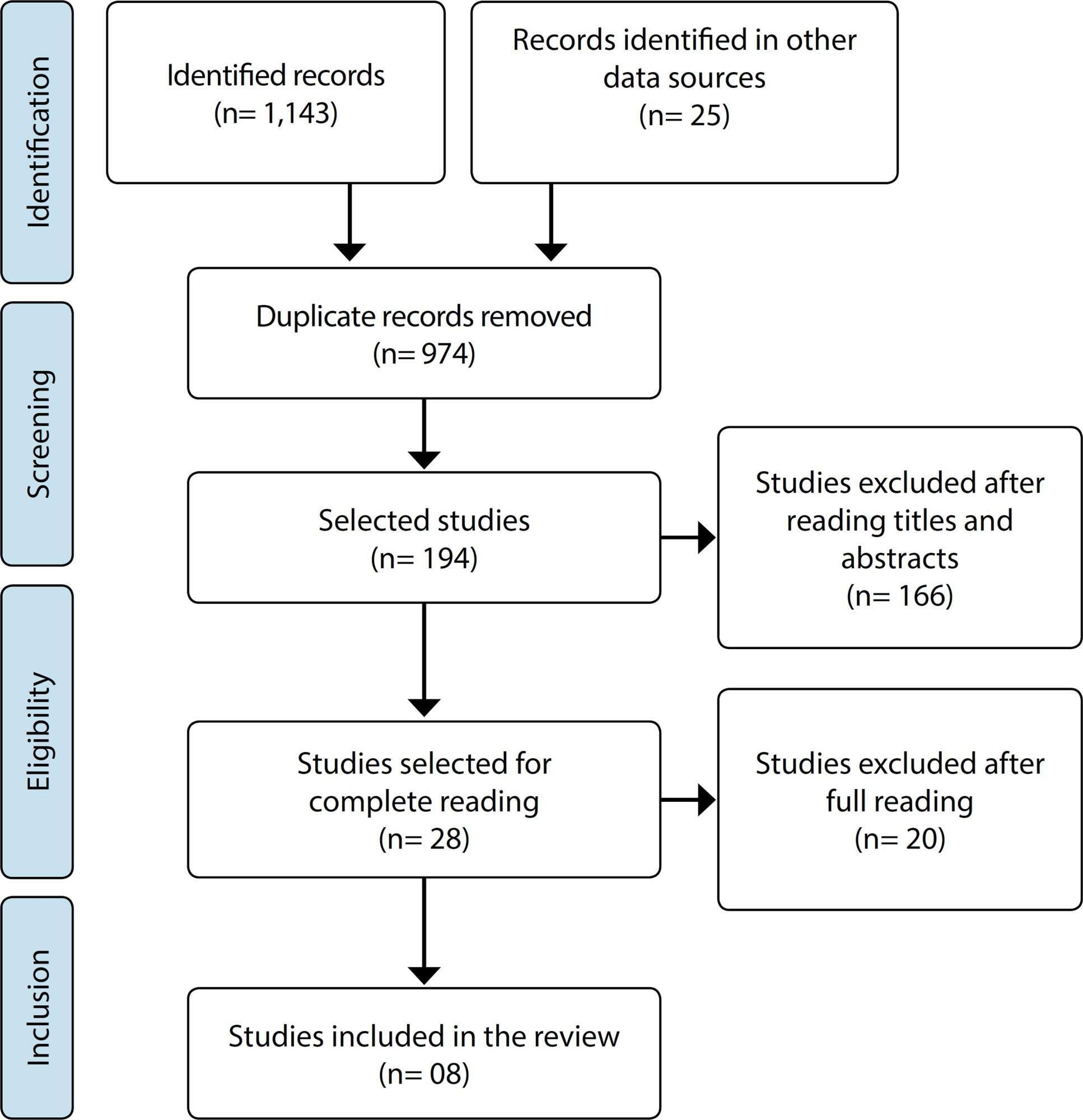
-
16/07/2021
Qualidade do sono e sua associação com os sintomas de menopausa e climatério
Revista Brasileira de Enfermagem. 2021;74:e20201150
Resumen
Qualidade do sono e sua associação com os sintomas de menopausa e climatério
Revista Brasileira de Enfermagem. 2021;74:e20201150
DOI 10.1590/0034-7167-2020-1150
Visualizações0Ver maisRESUMO
Objetivo:
Avaliar a qualidade do sono em mulheres menopausadas e sua associação com os sintomas relacionados a esse período.
Método:
Estudo transversal, analítico e correlacional. O sono foi avaliado por meio do Índice de Qualidade do Sono de Pittsburgh; e os sintomas do climatério, pelo Menopause Rating Scale. Para a comparação do escore total e de cada domínio do Menopause Rating Scale com a classificação do Índice de Qualidade do Sono de Pittsburgh (PSQI), foi utilizado o teste não paramétrico U de Mann-Whitney. Considerou-se valor p<0,05 como significante.
Resultados:
Foram classificadas 261 mulheres (67,8%) como más dormidoras. Houve correlação positiva e significativa dos escores da escala do sono com o escore total da menopausa e seus domínios. As mulheres categorizadas como más dormidoras apresentaram piores escores na escala de sintomas de menopausa.
Conclusão:
Mulheres com pior qualidade do sono revelaram maior severidade dos sintomas relacionados à menopausa.
-
ARTÍCULO ORIGINAL21/10/2019
“À espera de um milagre”: espiritualidade/religiosidade no enfrentamento da doença falciforme
Revista Brasileira de Enfermagem. 2019;72(6):1554-1561
Resumen
ARTÍCULO ORIGINAL“À espera de um milagre”: espiritualidade/religiosidade no enfrentamento da doença falciforme
Revista Brasileira de Enfermagem. 2019;72(6):1554-1561
DOI 10.1590/0034-7167-2018-0635
Visualizações1Ver maisRESUMO
Objetivo:
Compreender a Espiritualidade/Religiosidade vivenciadas por pessoas com doença falciforme e sua influência sobre o enfrentamento da doença.
Método:
Estudo qualitativo, descritivo, exploratório, realizado no Estado da Bahia. Participaram 29 pessoas que responderam a entrevistas semiestruturadas. O material empírico foi submetido a análise de conteúdo.
Resultados:
Pessoas com doença falciforme vivenciam a Espiritualidade/Religiosidade motivadas pela esperança de um milagre e por medo da morte; seus ritos são as leituras de textos religiosos, orações individuais e em grupo, e frequência a cultos; os efeitos sobre sua saúde são: conforto através do coping de comparação, alívio da ansiedade, apoio social, mudança no estilo de vida, porém a Espiritualidade/Religiosidade podem manifestar-se prejudicadas.
Considerações finais:
Este estudo ressalta a necessidade da qualificação dos profissionais de saúde para a abordagem das questões espirituais dessas pessoas adoecidas, com a preocupação de diagnosticar possíveis sofrimentos, angústias e assim prestar auxílio, conforto e fortalecer os vínculos espirituais desses indivíduos.
-
ARTÍCULO ORIGINAL18/10/2022
Clinical simulation as a Nursing Fundamentals teaching method: a quasi-experimental study
Revista Brasileira de Enfermagem. 2022;75(2):e20201155
Resumen
ARTÍCULO ORIGINALClinical simulation as a Nursing Fundamentals teaching method: a quasi-experimental study
Revista Brasileira de Enfermagem. 2022;75(2):e20201155
DOI 10.1590/0034-7167-2020-1155
Visualizações0Ver maisABSTRACT
Objectives:
to evaluate students’ knowledge gain after the implementation of clinical simulation in Nursing Fundamentals disciplines.
Methods:
a quasi-experimental intervention was carried out with 60 students, distributed in comparison and intervention groups, who underwent traditional teaching and traditional teaching associated with simulated teaching, respectively. Pre-test and post-test instruments were applied to both groups.
Results:
after analyzing the students’ performance through the applied instruments, both groups had a cognitive evolution along with the taught content, however, when compared, the intervention group obtained a higher knowledge gain than the comparison group (p = 0.016), demonstrating progressive and increasing improvement with the use of the methodology.
Conclusions:
simulated teaching significantly helps students in gaining technical-cognitive knowledge. Therefore, it is recommended to adhere to the use of this methodology for teaching Nursing Fundamentals.
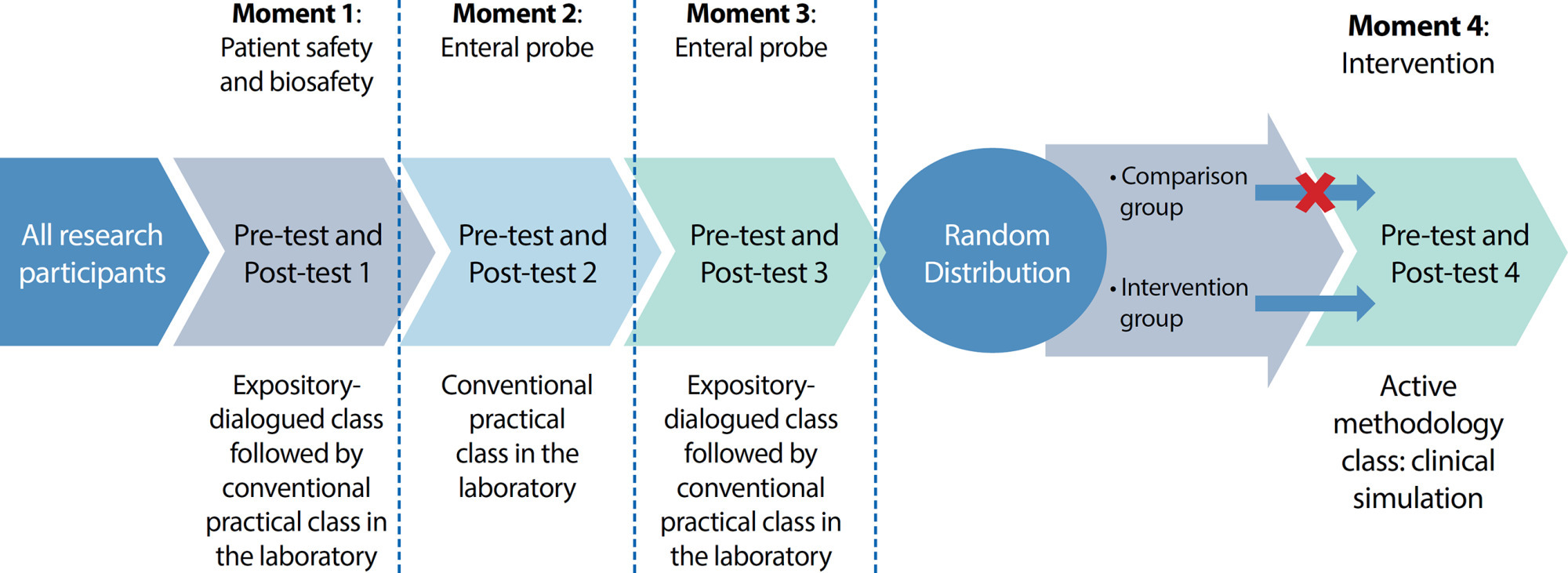
-
ARTÍCULO ORIGINAL10/02/2020
Depression among nursing students and its association with academic life
Revista Brasileira de Enfermagem. 2020;73(1):e20180173
Resumen
ARTÍCULO ORIGINALDepression among nursing students and its association with academic life
Revista Brasileira de Enfermagem. 2020;73(1):e20180173
DOI 10.1590/0034-7167-2018-0173
Visualizações0Ver maisABSTRACT
Objective:
To measure the levels of depression among Nursing students from a public institution of higher education and the association with aspects of academic life.
Method:
Analytical and quantitative study with 203 students from a higher education institution that uses active methodologies. We used Beck’s Depression Inventory and the Likert type scale of academic factors.
Results:
We verified that 19.2% had moderate or severe levels of depression. Higher levels of depression were associated with female gender (p=0.003), working more than 40 hours per week (p=0.047), spending more than 90 minutes to reach academic activities (p=0.043) and with 12 academic factors specific to routines of the studied institution.
Conclusion:
The results contribute to managers’ and professors’ reflection and analysis concerning nursing students’ mental health, in addition to indicating in which aspects there is a need to provide greater support to these students.
-
ARTÍCULO ORIGINAL01/10/2022
Factors associated with vulnerability and fragility in the elderly: a cross-sectional study
Revista Brasileira de Enfermagem. 2022;75(2):e20200399
Resumen
ARTÍCULO ORIGINALFactors associated with vulnerability and fragility in the elderly: a cross-sectional study
Revista Brasileira de Enfermagem. 2022;75(2):e20200399
DOI 10.1590/0034-7167-2020-0399
Visualizações0Ver maisABSTRACT
Objectives:
to assess factors associated with vulnerability and fragility in the elderly.
Methods:
crosssectional study with 384 elderly people in Fortaleza, Ceará. The Vulnerable Elders Survey and Clinical-Functional Vulnerability Index – 20 were used. Chi-square and Fisher’s exact tests were used for associations. In the analysis of the combined influence of risk factors, the stepwise logistic regression and multinomial regression methods were adopted.
Results:
251 (65.4%) non-vulnerable and 133 (34.6%) vulnerable elders. From the vulnerable elders analyzed, 42 (30.9%) are at high risk for frailty. Factors associated with vulnerability: age, gender, presence of comorbidities, hypertension, diabetes, osteoporosis and use of polypharmacy. There is a 30% increase in the chance of vulnerability for each additional drug. Physical activity reduces the chance of vulnerability by 60%. Factors associated with frailty: educational level; self-perception of health; comorbidities; polypharmacy.
Conclusions:
it is important to pay attention to the presence of arterial hypertension, osteoporosis, polypharmacy, and encourage the practice of physical activity.
Búsqueda
Buscar en:
Nuvem de Tags
Adolescente (85) Atenção Primária à Saúde (239) COVID-19 (91) Criança (91) Cuidados de Enfermagem (269) Educação em Enfermagem (151) Educação em Saúde (139) Enfermagem (930) Enfermagem Pediátrica (86) Estudantes de Enfermagem (77) Estudos de Validação (131) Família (87) Idoso (208) Promoção da Saúde (99) Qualidade de Vida (104) Saúde do Trabalhador (86) Saúde Mental (145) Saúde Pública (82) Segurança do Paciente (150) Tecnologia Educacional (100)



